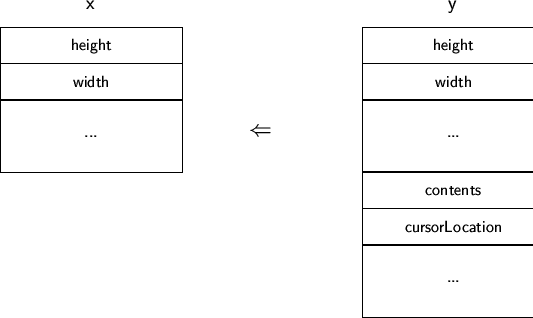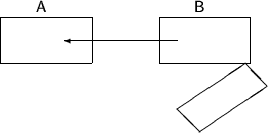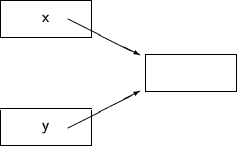Chapter 12, Outline
Introduction to Object Oriented Programming, 3rd Ed
Chapter 12
Implications of Substitution
Outline
- Roadmap
- Idealization of the is-a Relationship
- Memory Allocation - Stack and Heap Based
- The Problem with Substitution
- Memory Strategies
- Minimum Static Space Allocation
- Assigning a Larger Value to a Smaller Box
- The Slicing Problem
- Rules for Member Function Binding in C++
- Illustration
- Maximum Static Space Allocation
- Dynamic Memory Allocation
- Meaning of Assignment
- Copy Semantics versus Pointer Semantics
- Problems with Pointer Semantics
- An Old Joke Concerning Equality
- Equality and Identity
- Paradoxes of Equality, Part 1
- Paradoxes of Equality, Part 2
- Paradoxes of Equality, Part 3
- Chapter Summary
Other Material
Roadmap
In this chapter we will investigate some of the implications of
the principle of substitution in statically typed object-oriented
programming languages. In particular, we will consider:
- The impact on memory management
- The meaning of assignment
- The distinction between testing for identity and testing for equality
Intro OOP, Chapter 12, Slide 01
Idealization of is-a Relationship
-
A TextWindow is-a Window
-
Because TextWindow is subclassed from Window, all behavior
associated with Windows is also manifest by instances of TextWindow.
-
Therefore, a variable declared as maintaining an instance of Window
should be able to hold a value of type TextWindow.
Unfortunately, practical programming language implementation issues complicate
this idealized picture.
Intro OOP, Chapter 12, Slide 02
Memory Allocation - Stack and Heap Based
Generally, programming languages use two different techniques for allocation
of memory.
-
Stack-based allocation. Amount of space required is determined at
compile time, based on static types of variables.
Memory allocation and release is tied to procedure entry/exit.
Can be performed very efficiently.
-
Heap-based allocation. Amount of space used can be determined at
run-time, based upon dynamic considerations.
Memory allocation and release is not tied to procedure entry/exit,
and either must be handled by user or by a run-time library (garbage
collection). Generally considered to be somewhat less efficient.
Intro OOP, Chapter 12, Slide 03
The Problem with Substitution
class Window {
public:
virtual void oops();
private:
int height;
int width;
};
class TextWindow : public Window {
public:
virtual void oops();
private:
char * contents;
int cursorLocation;
};
|
Window x; // how much space to set aside?
TextWindow y;
x = y; // what should happen here?
|
Intro OOP, Chapter 12, Slide 04
Memory Strategies
How much memory should be set aside for the variable x ?
- 1.
- (Minimum Static Space Allocation)
Allocate the amount of space necessary for the base class only.
(C++)
- 2.
- (Maximum Static Space Allocation)
Allocate the amount of space for the largest subclass.
- 3.
- (Dynamic Space Allocation)
Allocate for x only the amount of space required to hold a pointer.
(Smalltalk, Java)
Intro OOP, Chapter 12, Slide 05
Minimum Static Space Allocation
The language C++ uses the minimum static space allocation approach.
This is very efficient, but leads to some subtle difficulties.
What happens in the following assignment?
Window x;
TextWindow y;
x = y;
Intro OOP, Chapter 12, Slide 06
Assigning a Larger Value to a Smaller Box

Intro OOP, Chapter 12, Slide 07
The Slicing Problem
The problem is you are trying to take a large box and squeeze it into a
small space. Clearly this won't work. Thus, the extra fields are simply
sliced off.
Question - Does this matter?
Answer - Only if somebody notices.
Solution - Design the language to make it difficult to notice.

Intro OOP, Chapter 12, Slide 08
Rules for Member Function Binding in C++
The rules for deciding what member function to execute are complicated
because of the slicing problem.
- 1.
- With variables that are declared normally, the binding of member function
name to function body is based on the static type of the argument
(regardless whether the function is declared virtual or not).
- 2.
- With variables that are declared as references or pointers, the
binding of the member function name to function body is based on
the dynamic type if the function is declared as virtual, and the static
type if not.
Intro OOP, Chapter 12, Slide 09
Illustration
void Window::oops()
{ printf("Window oops\n"); }
void TextWindow::oops()
{ printf("TextWindow oops %d\n", cursorLocation);
TextWindow x;
Window a;
Window * b;
TextWindow * c;
a = x; a.oops(); // executes Window version
b = &x; b->oops(); // executes TextWindow or Window version;
c = &x; c->oops(); // executes TextWindow version
Intro OOP, Chapter 12, Slide 10
Maximum Static Space Allocation
A different approach would be to allocate the Maximum amount of space
you would ever need.
-
Would nicely solve the slicing problem.
-
Would often allocate unused space.
-
Maximum amount of space not known until all classes have been seen.
-
For this reason, not used in practice.
Intro OOP, Chapter 12, Slide 11
Dynamic Memory Allocation
-
In the third approach, all objects are actually pointers.
-
Only enough space for a pointer is allocated at compile time.
-
Actual data storage is allocated on the heap at run-time.
-
Used in Smalltalk, Object Pascal, and Objective-C, Java.
-
Requires user to explicitly allocate new objects and, in some languages,
explicitly free no longer used storage.
-
May also lead to pointer semantics for assignment and equality testing.
Intro OOP, Chapter 12, Slide 12
Meaning of Assignment?
What does it mean whan an instance of a class is assigned to another variable?
class Box {
public int value;
}
Box x = new Box();
x.value = 7;
Box y = x;
y.value = 12; // what is x.value?
Two possibilities:
- Copy semantics. x and y are independent of each other, a change in one
has no effect on the other.
- Pointer semantcs. x and y refer to the same object, and hence
a change in one will alter the other.
Intro OOP, Chapter 12, Slide 13
Copy Semantics versus Pointer Semantics
If a value is indirectly accessed through a pointer, when an assignment
is performed (or equality test is made) is the quantity assigned
simply the pointer or is it the actual value?

Intro OOP, Chapter 12, Slide 14
Problems with Pointer Semantics
-
If x is assigned to y and then changes are made to x, are these changes
reflected in y?
-
If x is explicitly freed, what happens if the user tries to access
memory through y?
-
In C++, programmer can make assignment (equality testing) mean anything
they want.
-
Object Pascal, Java uses pointer semantics, no built-in provision for
copies.
-
Smalltalk and Objective-C use pointer semantics, have several techniques
for making copies.
Intro OOP, Chapter 12, Slide 15
An Old Joke Concerning Equality
There is an old joke that goes something like this: A man walks into
a pizza parlor and sits down. A waiter comes to the table and asks the
man what he would like to order. The man looks around the room, then
points to the woman sitting at the next table, and says ``I'll have what
she is eating.'' The waiter thereupon walks to the womans table,
picks up the half-eaten pizza from in front of her, and
places it before the startled customer.
A classic confusion between equality and identity.
Intro OOP, Chapter 12, Slide 16
Equality and Identity
- A test for identity asks whether two variables refer to exactly
the same object.
- A test for equality asks whether two variables refer to
values that are equivalent.
Of course, the meaning of equivalent is inheritently domain specific.
Object-oriented languages allow the programmer to control the meaning
of the equality test by allowing the redefinition of a standard method.
(for example, equals in Java).
Intro OOP, Chapter 12, Slide 17
Paradoxes of Equality, Part 1
But child classes cannot change the type signature of overridden methods.
This means the argument must often be more general than one would like:
class Object {
public boolean equals (Object right) {
...
}
}
class PlayingCard extends Object {
public boolean equals (Object right) {
... // right must be object even if we are only
... // interested in comparing cards to cards
}
}
Intro OOP, Chapter 12, Slide 18
Paradoxes of Equality, Part 2
Because equality is a message sent to the left argument, there is
no guarantee that properties such as symmetry or transitivity are preserved:
class Foo {
boolean equals (Object right) { ... }
}
Foo a, b;
if (a.equals(b)) // even if this is true
if (b.equals(a)) // no guarantee that this is true
Intro OOP, Chapter 12, Slide 19
Paradoxes of Equality, Part 3
And if you add inheritance into the mix, the possibilities for paradoxical
behavior increase even more.
class Parent {
boolean equals (Object x) { ... }
}
class Child extends Parent {
boolean equals (Object x) { ... }
}
Parent p;
Child c;
if (p.equals(c)) // will execute using the parent method
if (c.equals(p)) // will execute using the childs method
Intro OOP, Chapter 12, Slide 20
Chapter Summary
We have explored the implications that result from the inclusion of
the principle of substitution in an object oriented programming language.
- Because values are not known until run time, you either have
complex semantics (as in C++) or objects are dynamic (as in Java and most other
languages).
- Because objects are dynamic, most object-oriented languages end
up using a garbage collection system.
- Dynamic semantics naturally lean to pointer semantics for assignment
- Pointer semantics mean that equality and identity are two different
concepts
- Since equality is domain specific, the programmer must be free to
redefine the meaning as appropriate
- Because the programmer can redefine equality arbitrarily, there is
no guarantee that semantics of equals is preserved.
Intro OOP, Chapter 12, Slide 21



